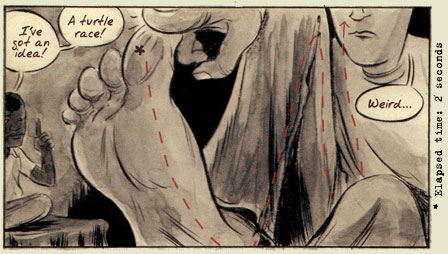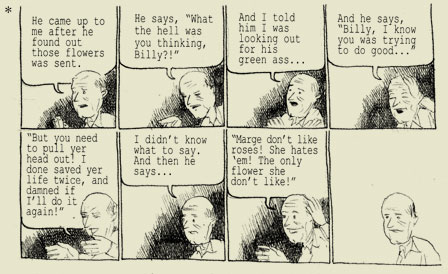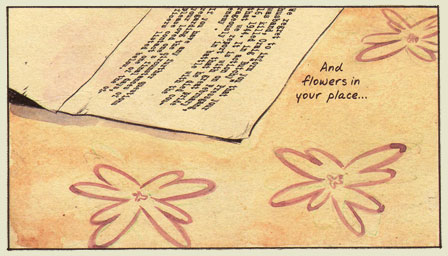3 Story: The Secret History of the Giant Man
As an author, there are a couple of ways to approach a sci-fi concept. One can take the idea and simply run with it, expecting readers to give in to the demands of suspendable disbelief. Alternatively, an author can exert a lot of effort to couch his concept in plausibilities, striving to explain things in scientific terms (or at least in terms that could be scientific). Each method has its fans, but generally in the last few decades anecdotal evidence leads me to think that all but the lowest common denominators in our culture appreciate authors who will put at least some effort into the conveyance of Believability. Most contemporary authors, I believe, will find themselves somewhere in the middle, wanting to focus on their stories but still feeling the responsibility to at least offer tacit explanations for the strange and amazing things that happen in their stories.
To that end, we have the writers of LOST toying with concepts of electro-magnetism and quantum theory. We find Brian K. Vaughan using socio-scientific theory to explain the plague he unleashes in Y: The Last Man. We get movies like Moon and Jurassic Park. We also have George Lucas turning the mystery of the Force into an empirically quantifiable convocation of microscopic organisms. (So it doesn't always result in wooing the audience.) Matt Kindt, with 3 Story, finds himself in this set of authors—and he succeeds better than many of them.

When you write a story about the tallest man in the world, a man who eventually will grow to be the size of skyscrapers, you may be tempted to leave it at that. Maybe settle on solely focusing on the troubles that go with (physically) not fitting in? Maybe let him be a hero worthy of his (physical) stature? I actually don't know what could be done in a story with a giant man. (I may actually have satisfied the whole of my interest in giant-man stories because Kindt's is so deliciously composed. More on composition later.) What Kindt does, beyond providing a throwaway explanation for Craig Pressgang's abnormal lifelong growth spurt, is propose a couple possibly reasonable side-effects to a human attaining such a size. I don't know how plausible Kindt's extrapolations of Pressgang's condition are, but they seem fairly reliable and may have been developed from verified difficulties experienced by Robert Wadlow, the Giant of Illinois (the tallest-recorded man in the world).

In the end Kindt's fidelity to medical accuracy, while a particular charm of 3 Story, is probably unnecessary to the effect of the work upon the reader. The book works well with these details but I imagine it would work well without them. At heart, the story of Craig's life (as told by the three primary women in his life) is about alienation and community. And while details like Craig's inability to register physical contact in meaningful ways heighten our sense of his distance from those around him, the tableaux on which Kindt paints is bleak enough that such particulars—while decorative—are not foundational to the work.
3 Story, though telling a single story, is (appropriately) divided into three discreet narratives. With growing awareness of the presence of a culture of sexism, a story narrated by three woman who tell the story of a man might put many readers on alert. After all, there continues to be a tendency in male-penned literary media to use females to magnify male protagonists. And while it's true that in many ways these three women's lives are circumscribed by Craig Pressgang's presence in their lives, the story might be seen as being at least as much about each of them as it is about Craig. Their lives are not defined so much by Craig's maleness as they are by their relationships to him and what his condition means to all four of them. 3 Story is the story of family and the alienation and closeness that can result when circumstances cause one member to be highlighted for good or ill. Craig, for much of the story, is an impenetrable person, walled off by his condition. It's in his mother's, wife's, and daughter's words and experiences that we learn who these people are and who tragedy will shape them to be. Kindt's treatment of his characters is often spare on words, but it's in gestures and timing that his tapestry of their heartbreaks unfurls.

Kindt resumes the kind of inventive page design and formal experimentation that was such a winning choice in Super Spy. I don't know how great an illustrator Kindt is—his style (as revealed in the three books of his I've read) is rather simple and keeps any sense of photorealism at arm's length. It doesn't really matter. He could be a terrible cartoonist who really just adores the opportunities of the medium. He could be Alex Toth. It doesn't matter. His drawing is good enough for the stories he drives because his design sense is impeccable. Similar to Adam Hines, whose visual work on Duncan the Wonder Dog was one of the stand-out comics achievements of 2010 (Hines is up front about not being a talented illustrator), Kindt uses a number of texturing tricks to add body and weight to his work. In addition, adding to 3 Story's visual aesthetic with what I presume is some handy photoshopping, Kindt relies on interview-style narrative interruptions as well as the kind of x-ray-style perspective that made Super Spy a treat. These little flourishes add an immeasurable something to the work and help elevate it from being merely another exploration of the human condition. Even in the depths of the human murk, Kindt displays an evident playfulness—and that sense of play makes more winning a vaguely morose story.

In writing about Kindt's Super Spy, I concluded:
The book’s strength instead lies in the very human way in which it approaches a world that is far beyond the coping mechanisms of its contributors. These people, no matter how thinly sketched, are always people—are always worth the time of your consideration. They are just as sad, broken, and hopeful as real people are and when their stories end, those conclusions are just as stupid, pointless, and tragic as they would be in real life.
This may be safely said of 3 Story as well. For while this book ends on a slightly more buoyant note, Kindt's story about a very tall man and the women whose lives his stature dominates is just as much about real people—no matter how fictional they may be.

Good Ok Bad features reviews of comics, graphic novels, manga, et cetera using a rare and auspicious three-star rating system. Point systems are notoriously fiddly, so here it's been pared down to three simple possibilities:
3 Stars = Good
2 Stars = Ok
1 Star = Bad
I am Seth T. Hahne and these are my reviews.
Browse Reviews By
Other Features
- Best Books of the Year:
- Top 50 of 2024
- Top 50 of 2023
- Top 100 of 2020-22
- Top 75 of 2019
- Top 50 of 2018
- Top 75 of 2017
- Top 75 of 2016
- Top 75 of 2015
- Top 75 of 2014
- Top 35 of 2013
- Top 25 of 2012
- Top 10 of 2011
- Popular Sections:
- All-Time Top 500
- All the Boardgames I've Played
- All the Anime Series I've Seen
- All the Animated Films I've Seen
- Top 75 by Female Creators
- Kids Recommendations
- What I Read: A Reading Log
- Other Features:
- Bookclub Study Guides










